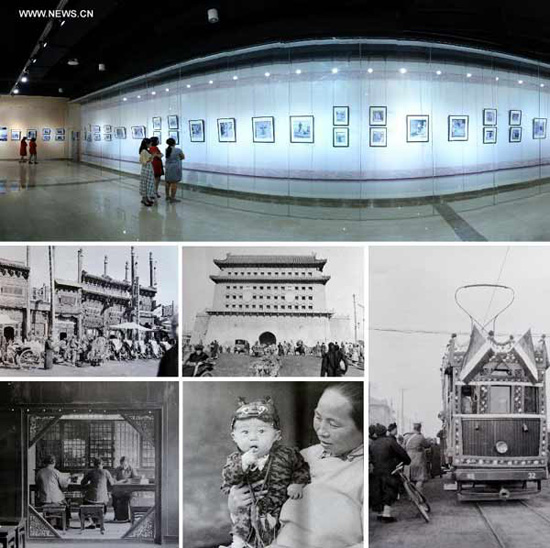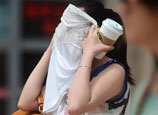
 |
| The combined photo taken on June 18, 2013 shows the displayed pictures during a photo exhibition showing the works of Sidney D. Gamble in Beijing, capital of China. The exhibition displayed more than 100 photos taken by Gamble depicting the life of Beijing from 1908 to 1931. (Xinhua/Li Xin) |
Photo works of Sidney D. Gamble exhibited in Beijing
BEIJING, June 18 (Xinhua) -- Rarely-seen images of China from more than 100 years ago will go on display as part of a new exhibition to be held at the Capital Library of China from June 16 to 30.
"Beijing Through Sidney Gamble's Camera" includes an array of pictures shot by the late photographer in the early 20th century, a turbulent period in Chinese history from which few photos survived.
Zhou Luo, one of the exhibition's curators and a Chinese studies librarian from Duke University, said at the exhibition's opening ceremony that Gamble's multiple roles helped to make the photos more interesting.
"He was not only an amateur photographer, but also a priest, ethnologist and sociologist," she said. "These allowed his photographic work to include different perspectives, from remarkable historic events to people's daily lives."
Some his photos capture notable events in history, like the May Fourth Movement and the funeral of Dr. Sun Yat-sen. But most of the photos depict ordinary urban people, architecture, religious customs, funerals and festivals, as well as other facets of pre-revolutionary society, Zhou said.
Sidney Gamble, grandson of James Gamble, the founder of Procter & Gamble, took his first picture during a family trip to China in 1908. From 1917 to 1932, he made another three trips to China, visiting several parts of the country. He later published socio-economic writings concerning China, but only a few of the images he took in China appeared in scholarly publications and lectures.
About 15 years after his death, his daughter Catherine Curran found a trove of photo negatives in a closet in the family's home in New York. Stored in rosewood boxes, the negatives were housed in individual paper sleeves and annotated with both typed and handwritten captions.
Trying her best to preserve the negatives, Curran signed an agreement in 2006 to bring the Gamble collection to Duke University. Now, the university holds 5,000 original negatives of Gamble's China photos.
"The university libraries first digitized the highly flammable nitrate negatives and then we spent two summers archiving them," Zhou said. "The most difficult part was clarifying the captions, which often had place names spelled according to old pronunciations."
After carefully studying the routes Gamble traveled when he visited China, Zhou managed to match some old names from Gamble's images with current places.
She also made some interesting discoveries. For example, in a photo showing a crowd of people gathering around a newspaper billboard, Gamble, in the caption, mistook the billboard for an old-fashioned door with a lintel.
Though Zhou and her colleagues have made great efforts to trace the stories behind each photo, they have decided not to present concise historical and biographical information about the photos in the exhibit. Only titles will be provided.
"We want to emphasize the relationship among the photographer, the photographed objects and the viewers," said Hong Guo-juin, another curator of the exhibit and associate professor of Chinese literature and culture at Duke University.
Both curators believe that with no background information, audiences can interpret Gamble's pictures in their own way.
"They have to dig into the photos' messages by themselves. It's a more vivid way to meet history," Hong said.
"Gamble In Chair" is one of many photos that the curators particularly enjoy. Gamble, sitting in a sedan chair, is shown surrounded by smiling chair carriers.
"They are smiling despite leading a hard life. Actually, there are many smiling faces in Gamble's photos, from teenagers in the poor boys' prison to children at a congee distribution area," Zhou said. "It's the moods expressed through the lens that are most fascinating."
The exhibition is a joint project between Duke University and the Capital Library of China. It is being held as part of several activities designed to commemorate the 100th founding anniversary of the library.
















 Sweating at Yoga club: white collars' new choice after work
Sweating at Yoga club: white collars' new choice after work


![]()
